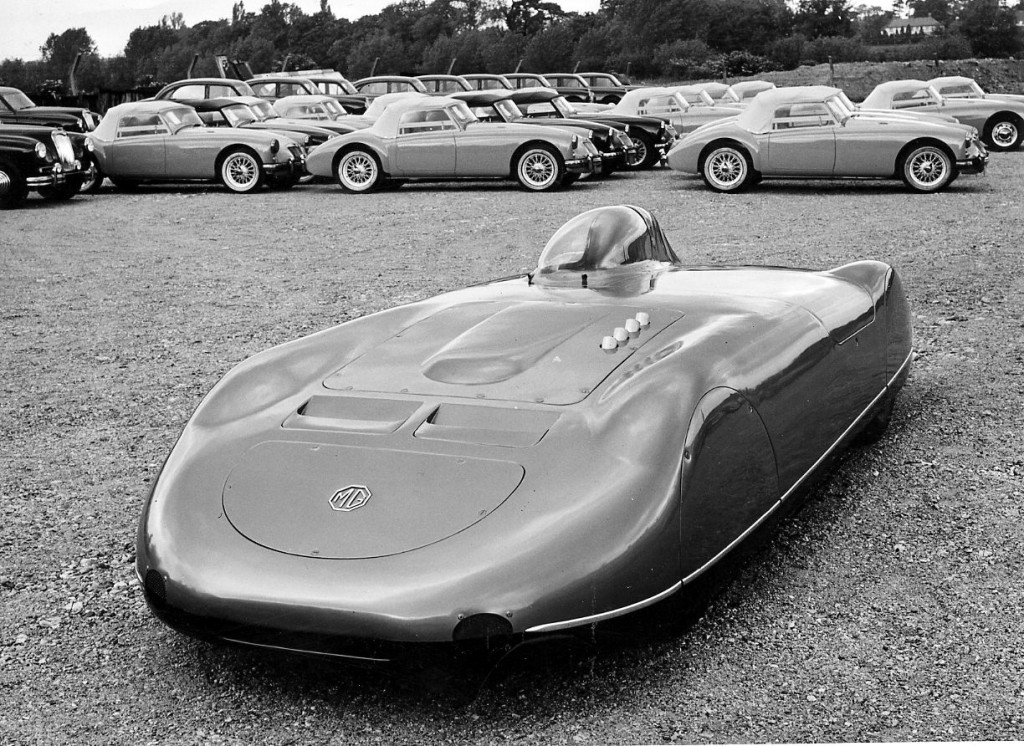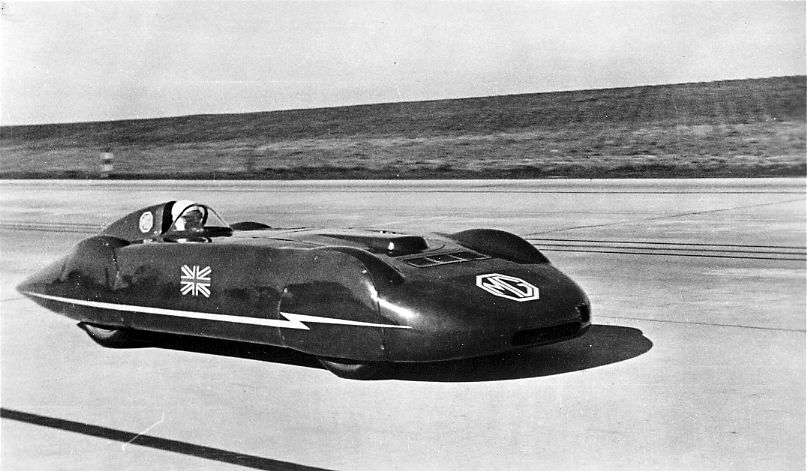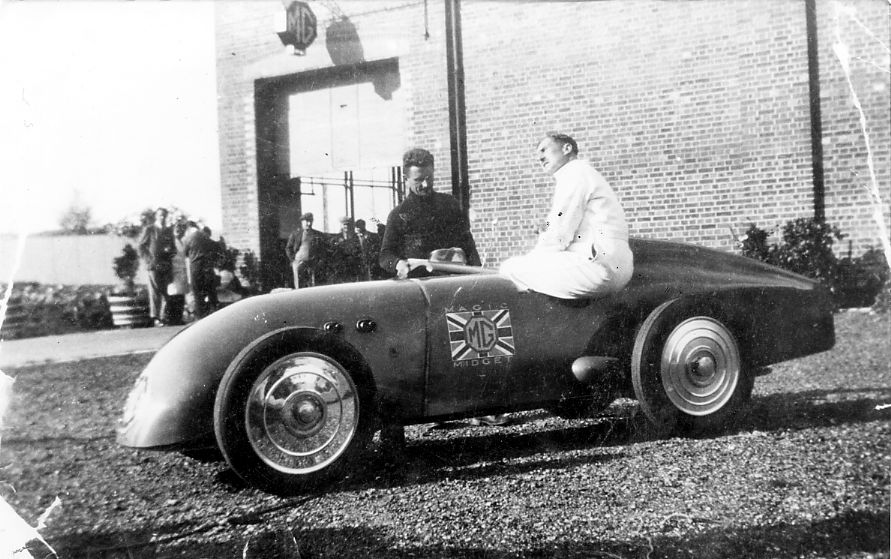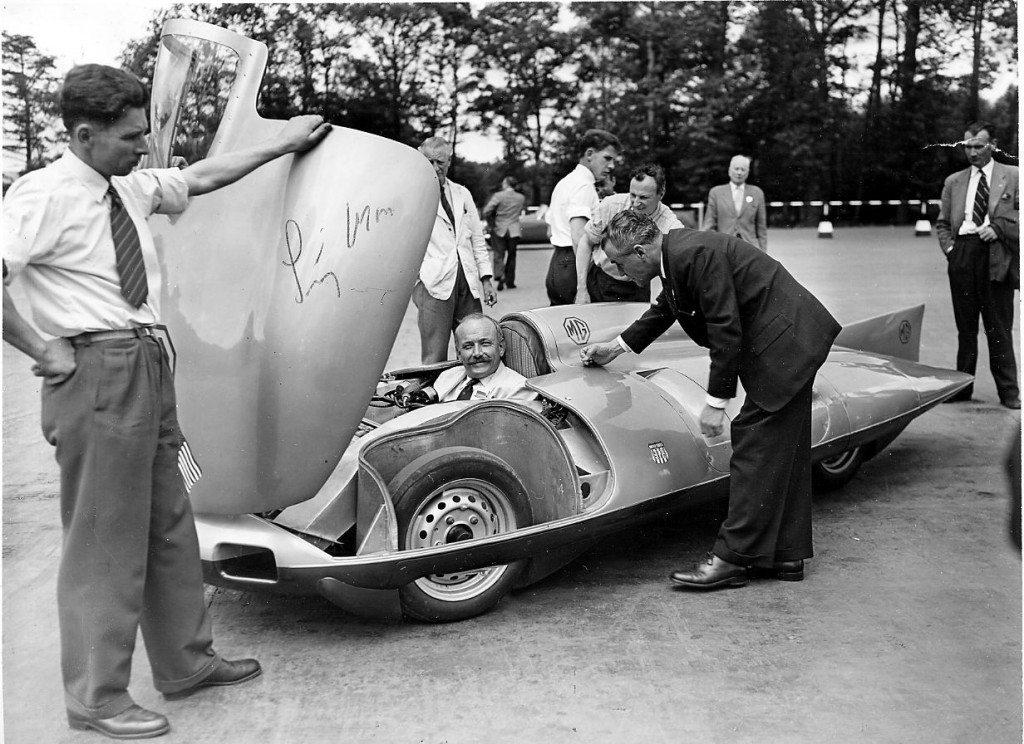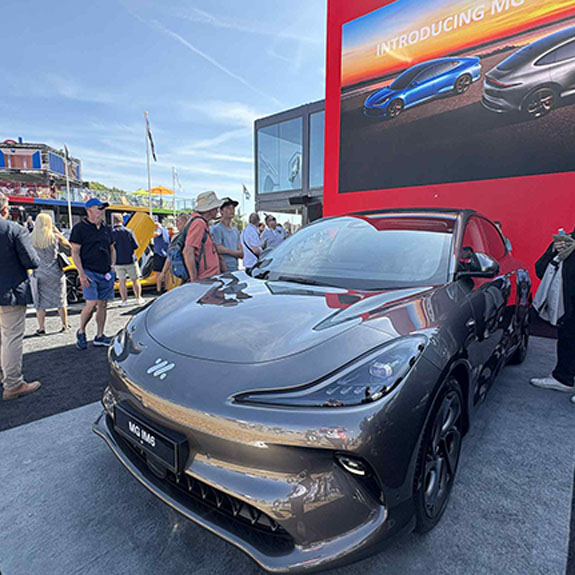Those EX numbers….
Reproduction in whole or in part of any article published on this website is prohibited without written permission of The MG Car Club.
John Thornley’s definitive paper on the original Abingdon EX numbers first published in the June 1959 issue of Safety Fast! and again in June 2001 is this week’s feature. Photos courtesy of Cliff Bray and Brian Moylan.
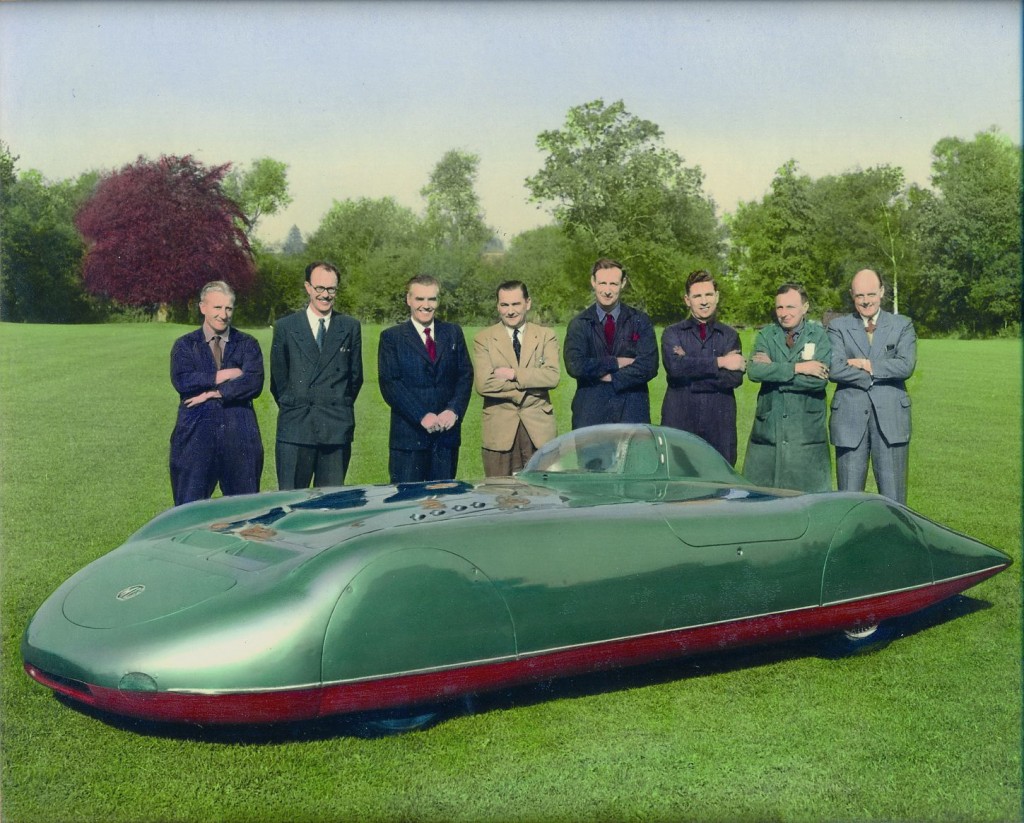 EX 179 with the designers and builder (left to right), Harold Wiggins (Development), Terry Mitchell (Chassis Design), Syd Enever (Chief Engineer), Alec Hounslow, Harry Riddell, Cliff Bray, Henry Stone (Development) and John Law (engines Branch).
EX 179 with the designers and builder (left to right), Harold Wiggins (Development), Terry Mitchell (Chassis Design), Syd Enever (Chief Engineer), Alec Hounslow, Harry Riddell, Cliff Bray, Henry Stone (Development) and John Law (engines Branch).
In MG circles there is a good deal of chat from time to time about EX.127, EX. 135, EX this, that, and the other and information reaching me indicates that folk are a bit confused. This is not altogether surprising, because at this moment I am a bit confused too, but by the time I have done the research and finished this article things should appear a good deal straighter.
There is a system once you begin to sort it out, but it proves to be a little difficult to start with because it had a rather shaky beginning.
Old Number One, all bullnosed cars, and all those with square radiators up to the end of 1927 bore the Morris Garages medallion-that is to say, the Oxford City crest surrounded by a garter bearing the inscription ‘The Morris Garages Ltd.’.
The name MG, and with it the now-familiar octagonal motif, did not come into use until the beginning of 1928, and first appeared on the Mark lVs of that year. It was during these later days of the Mark IV that the ‘M’ type Midget came into being, and all the cars up to that point were virtually Morris chassis fitted with special bodies. Other than minor modifications, no design work was done on chassis.
During 1928 design began of a distinct car which, though it incorporated a large number of standard Morris components and units, had a special chassis frame and many other mechanical variants peculiar to itself. This was the car which was later to be known as the MG Six (Mark I). In the early stages of its design three prototypes were built, all differing in detail, and referred to as EX.1, EX.2, and EX.3, respectively.
Not until they were built was the name Mark I applied to them, largely because, I suppose, few parents bother about the baby’s name at least until the doctor has forecast the birthday, and even then they can’t be sure!
Certainly EX.2, and possibly EX. I as well, were running on the road before the end of 1928, and in the early days of 1929; such was the impetuosity and the pace of those days, a decision was made to go ahead with an elaboration of the model, increasing the track by 4 in. and incorporating a four-speed gearbox. This work was undertaken under the label EX.4, the car finally emerging as the MG Six (Mark II).
As may be imagined, the development and subsequent improvement of these cars produced all manner of side-shoot investigations, and it was soon found to be an over-simplification to group all the work in connection with any one car under one number.
There was, moreover, a fairly high degree of interchangeability between them, and it could well be that one piece of research could relate to two or more models. The simplified system therefore broke down in its earliest days, and, taking advantage of the transfer of activities from Oxford to Abingdon and the formation of the MG Car Company Ltd, a new start was made at EX.101.
Under the new arrangement a fresh number was to be taken up for any particularly important piece of development work regardless of which model it applied to, or for that matter regardless of whether it applied to a model at all. So not every number gave rise to a motor-car not by a long way. For it to do so was the exception rather than the rule. Nos. 101 to 119 related variously to work on the then existing models, and with such things as the conversion of the ‘M’ type to its Double Twelve variation with outside Brooklands exhaust system, gauze wind- (or bug-) screen, and so on.
From among these numbers EX.115 stands out as the project which covered the super session of the ‘M’ type Morris Minor chassis frame by the classic MG frame, which was to persist right through to the ‘TC’ of 1947. This particular number, however, tended to lose its significance when work began on the first record-breaking car, the prototype of the ‘C’ type racing car, which was known throughout its life as EX.120.
This was the car which, in the hands of George Eyston, became the first car of 750 c.c. capacity to exceed 100 mph. and the first to cover 100 miles in the hour. It was at the conclusion of this latter epic that it caught fire under George Eyston, and after his hurried departure at some speed ended its career in ashes in the infield at Montlhery.
Owners of ‘TCs will find various parts of their machines, particularly the forgings which hold the various bits of the chassis frame together, stamped with the number EX.120. This indicates that these components are identical with those used in 1930.
To go through all the gamut of these numbers in sequence could be tedious and, to a large extent at this distance in time, meaningless, so we must hurry on, touching only upon those of particular significance. Among these EX.125 is worth a passing mention, as it covered all that high-pressure work in the latter half of 1931 developing the application of the supercharger to the ‘C’ type to enable the MG to keep in front simultaneously of the Austins and the handicappers.
EX.127 is a shining light. This was the Magic Midget, the 750 cc. single-seater record car, with oblique transmission, which, after a great deal of trying, in the face of all manner of misfortunes, was to achieve 120 mph again in the hands of George Eyston. It had a long and arduous life, and in 1935, when owned and driven by the German, Kohlrausch, put the stand-ing mile for Class H to 934 mph. and the flying mile to 140.6 mph.
EX.129 is down in the records as ‘F with 3 ft. 10 in. track’. Memories are a bit shaky as to precisely what this involved, and from an examination of the then readily avail-able components it is difficult to see how a 3 ft. 10 in. track could be obtained. But from the fact that the ‘F’ type was a six-cylinder and the ‘K’s with 4 ft. track began to emerge the following year, it seems probable that this was the first sortie into the realm of Magnettes.
However, from the fact that there seems always to be at Abingdon someone who remembers every experimental car ever built, and nobody remembers this one, it must be assumed that EX.129 is one of the many jobs which never got off the drawing board.
By contrast, EX.l30 most certainly did. All the exasperating but ultimately successful work on what was known as the ‘AB’ head was related to this number. Opposed porting was introduced on the ‘C’ type engine, incorporating the 14-mm. plug, and thereby ensuring continued racing successes during 1932.
The ‘K’ type in its numerous forms came to life under EX.131, and the specialised work on the ‘K3’ under EX.132, but here again no actual cars have passed into history under either of these numbers.
Of those that did, EX.135 is perhaps the most famous of them all.
This is the car, originally commissioned by George Eyston, which was based on the ‘K3’, with oblique transmission in the EX.127 manner and with alternative bodies for road-racing and record-breaking. This is the car, too, which came to be known colloquially as the ‘Humbug’, because of the finish of the bodies being in wide cream and brown stripes.
After a successful and spectacular career during 1934 and 1935, during which time it became the first car of its size to cover 120 miles in the hour, it passed into the limbo.
Resurrected again some two years later, this chassis formed the basis of Goldie Gardner’s famous record car, which, having raised the Class F and Class G Flying Mile records to over 200 mph. in 1939, continued record-breaking with a wide variety of engines almost annually (apart from the war years) up until Goldie’s retirement in 1953.
The next number of any significance, but which as a number rings no bells in the mind, is EX.147, the all-independently suspended single-seater racing car, the ‘R’ type. Though a number of these cars were made, and though they embarked upon a racing career, their development was not pursued, as at this stage the axe fell on the Company’s racing activities. The design was unquestionably far in advance of its time, and even now, in 1959, the design of passenger cars is only just beginning to catch up.
EX.150 tickles the fancy as it is down in the records as ‘3 1/2-litre independent car’, and among the very considerable list of drawings which were made at the time appears a sub-heading ‘banana-type rear suspension’. This reached a one-off proto-type stage with an enormous slab-sided body which earned the car the pseudonym ‘Queen Mary’, but work ceased, with the ‘R’ type, on the introduction of a programme of rationalisation of design with Morris Motors Ltd., a subsidiary of which the MG Car Company then became.
In pursuit of this programme a whole new series of designs was embarked upon, and there emerged the MG Midget type ‘TA’ under EX.155, the 2-litre type ‘SA’ under EX.158, and the l ½ litre ‘VA’ under EX.159. These were later followed in 1939 by EX.161, the 2.6 litre version, type ‘WA’.
Came the Second World War, which banished all thoughts of motor-car design and sports-car production, but before the tents were finally folded the number EX.166 was taken up and work started on the ‘YA’, the 1 ¼ litre saloon which was not to come into production until 1947.
One number, and one number only, was taken up during the war itself. This was EX.167, for a vehicle known as ‘Bitsy’, an internal transport prime mover for the Abingdon factory, made, as its name implies, from bits of this and bits of that.
During the 10 years immediately following the war, numbers have, with a few notable exceptions, related to special development projects connected with record-breaking activities. EX.175 was the car more popularly known by its registration number, HMO6, which grew out of George Phillips’ Le Mans ‘TD’ of 1952.
This, though work on it was shelved for the best part of a year from the middle of 1953, was the prototype of the ‘MGA’, and all subsequent develop-ment was conducted under this number. The shelving of this project accounted for the fact that an earlier car, the ‘TF’, had the later number EX.177.
EX.179 is the record car with the body based on Goldie Gardner’s, but with an ‘MGA’ chassis. This has appeared at Utah and In 1945, with unblown l ½ litre engine, it covered 10 miles at 153.69 m.p.h.
EX.181 is the high-speed holder of the Class F flying mile at 246 m.p.h.
At this stage things are getting much too modern and too interesting. The cats must be kept in their bags. Let us just say that EX.187 is the Twin Cam, and we are now up to EX.220! J.T.

 MG Car Club
MG Car Club